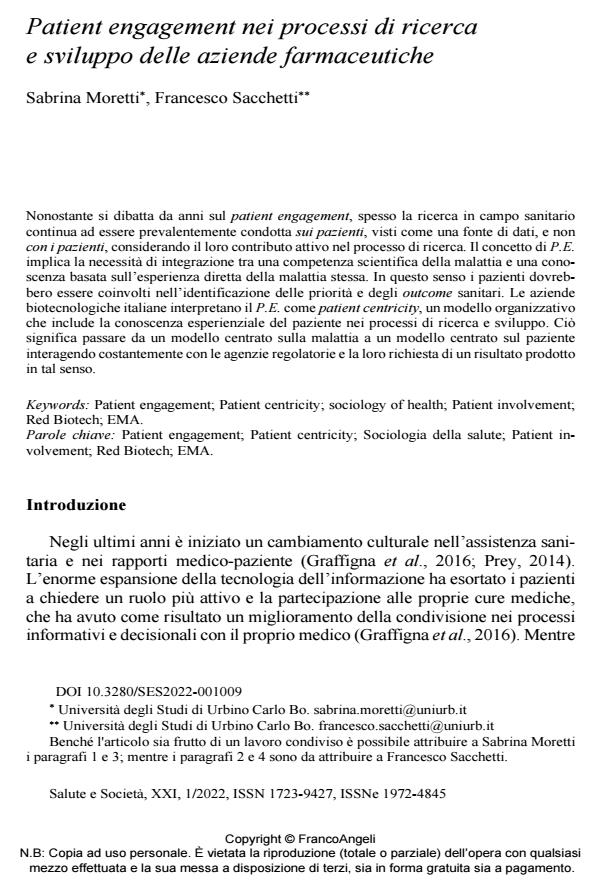Patient engagement nei processi di ricerca e sviluppo delle aziende farmaceutiche
Journal title SALUTE E SOCIETÀ
Author/s Sabrina Moretti, Francesco Sacchetti
Publishing Year 2022 Issue 2022/1 Language Italian
Pages 15 P. 128-142 File size 208 KB
DOI 10.3280/SES2022-001009
DOI is like a bar code for intellectual property: to have more infomation
click here
Below, you can see the article first page
If you want to buy this article in PDF format, you can do it, following the instructions to buy download credits

FrancoAngeli is member of Publishers International Linking Association, Inc (PILA), a not-for-profit association which run the CrossRef service enabling links to and from online scholarly content.
Nonostante si dibatta da anni sul patient engagement, spesso la ricerca in campo sanitario con-tinua ad essere prevalentemente condotta sui pazienti, visti come una fonte di dati, e non con i pazienti, considerando il loro contributo attivo nel processo di ricerca. Il concetto di P.E. im-plica la necessità di integrazione tra una competenza scientifica della malattia e una conoscenza basata sull’esperienza diretta della malattia stessa. In questo senso i pazienti dovrebbero essere coinvolti nell’identificazione delle priorità e degli outcome sanitari. Le aziende biotecnologiche italiane interpretano il P.E. come patient centricity, un modello organizzativo che include la conoscenza esperienziale del paziente nei processi di ricerca e sviluppo. Ciò significa passare da un modello centrato sulla malattia a un modello centrato sul paziente interagendo costante-mente con le agenzie regolatorie e la loro richiesta di un risultato prodotto in tal senso.
Keywords: Patient engagement; Patient centricity; sociology of health; Patient involvement; Red Biotech; EMA.
- Altieri L. (2009). Valutazione e partecipazione. Metodologia per una ricerca interattiva e negoziale. Milano: FrancoAngeli.
- Anand A., Brandwood H.J., Evans M.J. (2017). Improving patient involvement in the drug development process: Case study of potential applications from an online peer support network. Clinical therapeutics, 39(11): 2181-2188.
- Boivin A., Lehoux P., Lacombe R., Burgers J., Grol R. (2014). Involving patients in setting priorities for healthcare improvement: a cluster randomized trial. Implementation Science, 9: 1-10.
- Boutin M., Dewulf L., Hoos A., Geissler J., Todaro V., Schneider R.F., Garzya V., Garvey A., Robinson P., Saffer T., Krug S., Sargeant I. (2017). Culture and process change as a priority for patient engagement in medicines development. Therapeutic innovation & regulatory science, 51: 29-38.
- Callon M., Rabeharisoa V. (2003). Research “in the wild” and the shaping of new social identities. Technology in society, 25: 193-204.
- Caron-Flinterman J.F., Broerse J.E., Bunders J.F. (2005). The experiential knowledge of patients: a new resource for biomedical research?. Social science & medicine, 60: 2575-2584.
- Duffett L. (2017). Patient engagement: what partnering with patient in research is all about. Thrombosis research, 150: 113-120.
- EMA and HMA (2015). EU Medicines Agencies Network Strategy to 2020–Working together to improve health. -- Testo disponibile al sito: https://www.ema.europa.eu/en/documents/other/eu-medicines-agencies-network-strategy-2020-working-together-improve-health_en.pdf (20/01/2021).
- EMA (2014). Incorporating patients’ views during evaluation of benefit-risk by the EMA Scientific Committees. -- Testo disponibile al sito https://www.ema.europa.eu/en/documents/other/incorporating-patients-views-during-evaluation-benefit-risk-european-medicines-agency-scientific_en.pdf (15/01/2021).
- Graffigna G., Barello S., Triberti S. (2016). Patient engagement: A consumer-centered model to innovate healthcare. Warsaw/Berlin: Walter de Gruyter GmbH & Co KG.
- Guston D.H. (2004). Responsible innovation in the commercialised university. In: Stein D.G. (ed.), Buying in or Selling Out: The Commercialisation of the American Research University. New Brunswick: Rutgers.
- Hayes H., Buckland S., Tarpey M. (2012). Briefing notes for researchers: public involvement. In: NHS, Public health and social care research. Eastleigh: INVOLVE.
- Health Innovation Report (2014). “Raising the Bar on Health System Performance”, Report #8: Patients as Partners. -- Disponibile al sito: http://www.healthinnovationforum.org/wp-content/uploads/2014/01/Patients-as-partners_2015.pdf (25/01/2021).
- Higgins T., Larson E., Schnall R. (2017). Unraveling the meaning of patient engagement: a concept analysis. Patient Education and Counseling, 100(1): 30-36.
- Hoos A., Anderson J., Boutin M., Dewulf L., Geissler J., Johnston G., Joos A., Metcalf M., Regnante J., Sargeant I., Schneider R.F., Todaro V., Tougas G. (2015). Partnering with patients in the development and lifecycle of medicines: a call for action. Therapeutic innovation & regulatory science, 49(6): 929-939.
- Jacob K. (2013). Options for Strengthening Responsible Research and Innovation. European Commission. -- Testo disponibile al sito: https://ec.europa.eu/research/science-society/document_library/pdf_06/options-for-strengthening_en.pdf (18/01/2021).
- Jones R. (2008). When it pays to ask the public. Nature Nanotechnology, 3(10): 578-579.
- Owen R. (2012). From co-operative values to responsible innovation. Projectics/Proyéctica/Projectique, 2: 5-12.
- Pushparajah D.S. (2018). Making patient engagement a reality. The Patient-Patient-Centered Outcomes Research, 11: 1-8.
- Rabeharisoa V., Moreira T., Akrich M. (2014). Evidence-based activism: Patients’, users’ and activists’ groups in knowledge society. BioSocieties, 9: 111-128.
- van den Hoven J. (2013). Value Sensitive Design and Responsible Innovation. In: Owen R., Bessant J. e Heintz M. (eds) Responsible Innovation. New York: Wiley.
- Wilsdon J., Wynne B., Stilgoe J. (2005). The public value of science. London: Demos.
- Levitan B., Getz K., Eisenstein E.L., Goldberg M., Harker M., Hesterlee S., Patrick-Lake B., Roberts J.N., DiMasi J. (2018). Assessing the financial value of patient engagement: a quantitative approach from CTTI’s patient groups and clinical trials project. Therapeutic innovation & regulatory science, 52(2): 220-229.
- Lund Declaration (2009). New Worlds–New Solutions. Research and Innovation as a Basis for Developing Europe in a Global Context. Conference, Lund, Sweden, 7–8 July 2009.
Sabrina Moretti, Francesco Sacchetti, Patient engagement nei processi di ricerca e sviluppo delle aziende farmaceutiche in "SALUTE E SOCIETÀ" 1/2022, pp 128-142, DOI: 10.3280/SES2022-001009